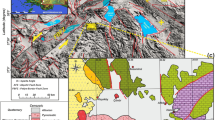Abstract
The Abbottabad basin is mainly composed of different loose and indurated sediments such as fine to medium grain silt and clay and large to medium sized boulders and cobbles, occupying a low land between the hills. These sediments are primarily stream deposits and variably compacted in the form of rock, suggested name Havelian group after their maximum thickness into Havelian area. Numerous streams converge at the Abbottabad intermontane basin from the north–northeast and join to form a single channel that passes through a narrow gorge on the western side of the Sirban hill. Geomorphically, the Abbottabad city is underlain by a thick sequence of loose Quaternary–Recent alluvial sediments, making it vulnerable to seismic hazards. This research determines the sediment thickness for the Abbottabad basin using a geophysical approach. In this regard, thirteen lithologic profiles were developed in the Abbottabad basin at different locations. These profiles were ultimately combined to develop a Fence diagram showing a generalized stratigraphic pattern of the Quaternary–Recent unconsolidated sediments in the basin. Standard Penetration Test (SPT) and H/V analysis were used to characterize the site and shear wave velocity at a different location of Abbottabad basin and surrounding area. Based on H/V data (using Tromino Engy Plus instrument) Abbottabad basin and immediate surroundings have an average fundamental frequency from 0.5 to 9 Hz, which represents the deposition of alluvial sediments (i.e., stiff and dense soil).









Similar content being viewed by others
References
Albarello D, Cakir R and Walsh T J 2011 Testing joint application of HVSR ambient vibration measurements and MASW seismic survey in the Puget Lowland and Coastal Area, Washington; Seismol. Res. Lett. 82(2) 300.
Alvarez W 2010 Protracted continental collisions argue for continental plates driven by basal traction; Earth Planet. Sci. Lett. 296(3–4) 434–442.
DiPietro J A and Pogue K R 2004 Tectonostratigraphic subdivisions of the Himalaya: A view from the west; Tectonics 23, https://doi.org/10.1029/2003TC001554.
Hussain A, Yeats R S and MonaLisa 2009 Geological setting of the 8 October, 2005 Kashmir earthquake; J. Seismol. 13(3) 315–325.
Ibs-Von Seht M and Wohlenberg J 1999 Microtremor measurements used to map thickness of soft sediments; Bull. Seismol. Soc. Am. 89 250–259.
Khan S and Khan M A 2016 Mapping sediment thickness of the Islamabad city using empirical relationships: Implications for seismic hazards assessment; J. Earth Syst. Sci. 125(3) 623–644, https://doi.org/10.1007/s12040-016-0675-0.
Latif M 1970 Explanatory notes on the geology of southeastern Hazara to accompany the revised geological map; Jahrb Geol. Bundesanst 15 5–20.
Grilla Software 2012 Software for passive/active surface wave analysis and modeling and vibration analysis, Italy (www.tromino.it).
GSP 2002 Geological map of Abbottabad area NWFP, Pakistan; Map series Vol. III, no. 97, Scale 1:50,000, Issued by Gauhar S H, Director General, Geological Survey of Pakistan.
MonaLisa, Khwaja A A and Jan M Q 2007 Seismic hazard assessment of the NW Himalayan fold-and-thrust belt, Pakistan, using probabilistic approach; J. Earthq. Eng. 11(2) 257–301.
Nakamura Y A 1989 A method for dynamic characteristics estimation of subsurface using microtremor on the ground surface; Quarterly Rep. RTRI 30(1).
NEHRP 1997 Commentary on the guidelines for the seismic rehabilitation of buildings. Federal Emergency Management Agency, Washington DC, USA.
Seeber L and Armbruster J 1979 Seismicity of the Hazara arc in northern Pakistan: Decollement vs. basement faulting; In: Geodynamics of Pakistan, Geological Survey of Pakistan, Quetta, pp. 131–147.
SESAME 2004 Guidelines for the implementation of the H/V spectral ratio technique on ambient vibrations; SESAME European Project.
Shahzada K 2011 Seismic risk assessment of buildings in Pakistan; PhD Dissertation, University of Engineering and Technology, Peshawar, Pakistan.
Tahirkheli R K, Mattauer M, Proust F and Tapponnier P 1979 The India Eurasia suture zone in northern Pakistan: Synthesis and interpretation of recent data at plate scale; In: Geodynamics of Pakistan, Geological Survey of Pakistan, Quetta, pp. 125–130.
Acknowledgements
This study is part of the M.Phil thesis at the National Centre of Excellence in Geology (NCEG), University of Peshawar. The instrumentation used in this study and all logistic support for the fieldwork were provided by the NCEG, which is gratefully acknowledged. Assistance in field and use of Grilla software by Ahmad Hammad Khaliq and Mian Luqman Hussain is greatly appreciated.
Author information
Authors and Affiliations
Corresponding author
Additional information
Corresponding editor: Piyush Shanker Agram
Rights and permissions
About this article
Cite this article
Hussain, Z., Khan, S., Khan, M.A. et al. Mapping sediment thickness of the Abbottabad basin, Pakistan. J Earth Syst Sci 128, 7 (2019). https://doi.org/10.1007/s12040-018-1025-1
Received:
Revised:
Accepted:
Published:
DOI: https://doi.org/10.1007/s12040-018-1025-1




